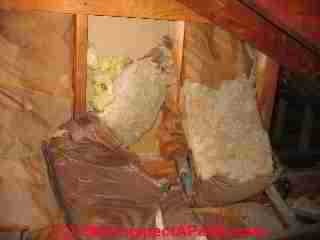 Insulation Air Bypass Leaks, Voids & Heat Loss Analysis for buildings
Insulation Air Bypass Leaks, Voids & Heat Loss Analysis for buildings
- POST a QUESTION or COMMENT about air bypass leaks and leak detection in building insulation systems
Insulation air leak troubleshooting: this article describes the types of air leaks that occur in building insulation systems and explains how to track down and fix these energy loss problems.
This article series discusses air bypass leaks, thermal convection loops, voids & leaks in building insulation, including fiberglass, chopped fiberglass, icynene foam, and blown-in cellulose.
Our page top photo shows a void in wall insulation, viewed from a seldom-visited attic. An insulation void such as this one should show up easily during an infrared building scan using thermal imaging. But unless the homeowner thinks of this step, the uninsulated wall may pump heat out of the building for years.
InspectAPedia tolerates no conflicts of interest. We have no relationship with advertisers, products, or services discussed at this website.
- Daniel Friedman, Publisher/Editor/Author - See WHO ARE WE?
Leaky Fiberglass Insulation?
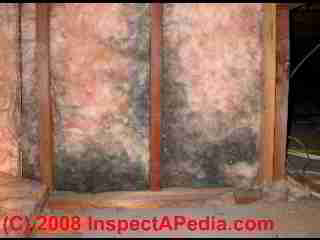
In our Solar Age Magazine article on building heat loss, AIR LEAK DETECTION TOOLS, according to Gadsby from PEP, fiberglass insulation will not block convective loop escape routes for a building's heat: Gadsby's view is that fiberglass does not stop airflow in wall cavities.
That article says that infrared scanners tell the same story, showing heat loss around and even through fiberglass insulation--even the massive batts in a superinsulated ceiling. For that reason, the PEP partners prefer blown insulation over fiberglass batts. With loose-fill fiberglass insulation, they believe, the airflow paths are circuitous enough to stop short any airflow.
Our photo (above left) shows the black stains deposited by dust particles (this is not mold) when building air leaks past fiberglass insulation, seen from the attic side of a 1960's contemporary framed home with lots of air leaks.
In our photo and in many air leak problems at fiberglass-batt insulated cavities, the problem is one of installation and construction leak problems, not a defect in the fiberglass insulating batt itself.
OPINION-DJF: we pose that loose-fill insulation may do a more consistent job of closing air or thermal bypass leaks that are sometimes left around fiberglass batts - that's the real problem.
Looking at an IR scan that shows heat loss "through" an insulating batt, if combined with visual inspection, using invasive cuts if necessary, will, we predict, show air bypass leaks, other insulation installation errors, or insulation wet from building leaks. Otherwise we should not see large solid areas of no-leaks on IR scans of walls and ceilings that have tightly-installed batts, no voids, and no penetrations.
The claim of fiberglass batt air leakage, supported vigorously by the foam insulation industry, is equally vigorously counter-argued by the fiberglass insulation companies who point out that properly installed the air flow rate through the fiberglass itself in fiberglass insulated cavities is very low.
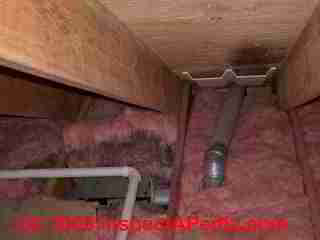 OPINION-DJF: air leaks around insulating batts that are not snugly fit between building framing members or where openings have been cut for ceiling lights, electrical boxes, plumbing chases, and voids left from workers who move or remove insulation appear from visual inspection to be the prime culprit, rather than air movement through the fiberglass insulating batt itself.
OPINION-DJF: air leaks around insulating batts that are not snugly fit between building framing members or where openings have been cut for ceiling lights, electrical boxes, plumbing chases, and voids left from workers who move or remove insulation appear from visual inspection to be the prime culprit, rather than air movement through the fiberglass insulating batt itself.
Our attic photo (left) shows both air bypass leaks (black stains on the fiberglass batt at center-left of the photo) and an insulation void (above the bath vent fan).
Where air leaks occur around fiberglass batts, look closely: you will probably see that the leaks are at the perimeter of the insulation and at locations where openings in framing, drywall, or insulation were cut to admit recessed ceiling lights, electrical or plumbing penetrations, or similar openings.
If airflow were simply through the fiberglass batt in any uniform way, the dust stains on and inside the insulation would also be expected to be uniform. They are not.
See Air Bypass Leaks, Thermal Tracking for details.
Leaky Icynene Foam Insulation?
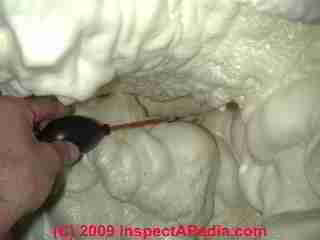 ...
... 
We full agree with PEP, however, that predicting air leaks through fiberglass-insulated cavities is very difficult, since leakage depends on the quality of installation workmanship. We have indeed occasionally found workmanship errors that resulted in unanticipated air leaks though foam-sprayed insulation as well, particularly when the insulation (of either type) was installed in a hard-to-access space such as a crawl area.
Our pair of photos above were taken in a tight, hard to enter crawl area where the icynene spray foam insulation was not so carefully applied.
Our smoke test found air movement from the damp, occasionally moldy crawl area into an opening in the foam insulating blanket. We pulled a bit of this already-leaky material off to see what was behind and found (photo above right) a leaky metal return air duct.
When the air handler was running it was drawing cold, sometimes nasty, crawl space air into the duct system through this leak.

Take a look at our foam retrofit photo at above left. We noticed two impressive details: a flood of foam entered this attic space over the un-heated garage (the insulator just pumped away, thinking he was foaming into an enclosed wall cavity).
But at the photo's upper right we see a shiny metal foil surface (a pre-existing radiant barrier) but no insulation whatsoever.
See ICYNENE FOAM SPRAY INSULATION for more information on icynene foam insulation.
Leaky Cellulose Building Insulation?
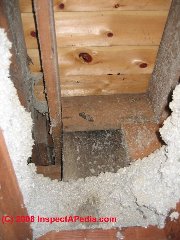
Our photo (left) shows a very large void in the building attic's blanket of blown-in cellulose insulation where no provision was made to insulate around a chimney chase.
Blown-in building insulation is often packed tightly between building framing members and other surfaces, and is likely to pose fewer air bypass leaks than sloppily-installed fiberglass batts (discussed above).
But precisely because blown-in cellulose is often selected for an insulation retrofit in older homes that may have had little or even no insulation previously, there is the risk that the insulator fails to notice and handle trouble spots such as the one shown in our photo.
Chopped-fiberglass blown-in insulation, and any pumped or blown insulating product that is sent into building cavities where there is no direct view all face the risk of unexpected voids.
For example in post-and-beam structures and converted barns, experienced retrofit insulation contractors have learned to watch out for the wall framing blockage formed by diagonal bracing. The contractor will drill extra openings to be sure that no insulation voids are left in the building walls.
See CELLULOSE LOOSE FILL INSULATION for more information.
How to Find Points of Heat Loss & Building Air Leaks
The article HEAT LOSS DETECTION TOOLS explains how to survey a building for air and heat loss or gain points and how to correct them. Just below are links to images of pages from "House Doctors with Better Medicine, Princeton Energy Partners use the latest diagnostic tools to comb a house for the major causes of heat loss. Their findings are often astonishing. Their strong prescriptions bring results", Steven Bliss, rom Solar Age Magazine.
In this article the author, Steven Bliss, accompanies a building weatherization and energy-savings company through a detailed building inspection for heat loss points, convective loops, and air leaks.
The author accompanies Princeton Energy Partners as they use thermal imaging, smoke guns, and visual inspection to pinpoint building air leaks, heat loss points, air infiltration and air exfiltration on a building.
The importance of setting priorities for sealing these points of energy wasted is emphasized and discussed, and sketches as well as photographs of common points of building heat loss, or unwanted heat gain, and air leaks are provided.
- Building Heat Loss & Air Leaks - use your browser's back button to return to this page
- Building Heat Loss & Air Leaks - part 2
- Building Heat Loss & Air Leaks - part 3
- Building Heat Loss & Air Leaks - part 4
The text above significantly expands, and also paraphrases, quotes-from, and comments an original article, "House Doctors with Better Medicine", Steven Bliss, (see links just above) from Solar Age Magazine.
...
Continue reading at AIR & HEAT LEAK FIXES or select a topic from the closely-related articles below, or see the complete ARTICLE INDEX.
Or see these
Recommended Articles
Suggested citation for this web page
INSULATION AIR & HEAT LEAKS at InspectApedia.com - online encyclopedia of building & environmental inspection, testing, diagnosis, repair, & problem prevention advice.
Or see this
INDEX to RELATED ARTICLES: ARTICLE INDEX to BUILDING ENERGY SAVINGS
Or use the SEARCH BOX found below to Ask a Question or Search InspectApedia
Ask a Question or Search InspectApedia
Questions & answers or comments about air bypass leaks and leak detection in building insulation systems.
Try the search box just below, or if you prefer, post a question or comment in the Comments box below and we will respond promptly.
Search the InspectApedia website
Note: appearance of your Comment below may be delayed: if your comment contains an image, photograph, web link, or text that looks to the software as if it might be a web link, your posting will appear after it has been approved by a moderator. Apologies for the delay.
Only one image can be added per comment but you can post as many comments, and therefore images, as you like.
You will not receive a notification when a response to your question has been posted.
Please bookmark this page to make it easy for you to check back for our response.
Our Comment Box is provided by Countable Web Productions countable.ca
Citations & References
In addition to any citations in the article above, a full list is available on request.
- Solar Age Magazine was the official publication of the American Solar Energy Society. The contemporary solar energy magazine associated with the Society is Solar Today. "Established in 1954, the nonprofit American Solar Energy Society (ASES) is the nation's leading association of solar professionals & advocates. Our mission is to inspire an era of energy innovation and speed the transition to a sustainable energy economy. We advance education, research and policy. Leading for more than 50 years. ASES leads national efforts to increase the use of solar energy, energy efficiency and other sustainable technologies in the U.S. We publish the award-winning SOLAR TODAY magazine, organize and present the ASES National Solar Conference and lead the ASES National Solar Tour – the largest grassroots solar event in the world."
- Steven Bliss served as editorial director and co-publisher of The Journal of Light Construction for 16 years and previously as building technology editor for Progressive Builder and Solar Age magazines. He worked in the building trades as a carpenter and design/build contractor for more than ten years and holds a masters degree from the Harvard Graduate School of Education.
Excerpts from his recent book, Best Practices Guide to Residential Construction, Wiley (November 18, 2005) ISBN-10: 0471648361, ISBN-13: 978-0471648369, appear throughout this website, with permission and courtesy of Wiley & Sons. Best Practices Guide is available from the publisher, J. Wiley & Sons, and also at Amazon.com.
Excerpts with updates and annotations expanding the original Best Practices Guide text can be found in the online review and book summary at BEST CONSTRUCTION PRACTICES GUIDE and also at DECK & PORCH CONSTRUCTION, at INDOOR AIR QUALITY IMPROVEMENT GUIDE, and in other articles found at InspectAPedia.com such as HOUSEWRAP AIR & VAPOR BARRIERS, also SOUND CONTROL in buildings, and other topics. - Our recommended books about building & mechanical systems design, inspection, problem diagnosis, and repair, and about indoor environment and IAQ testing, diagnosis, and cleanup are at the InspectAPedia Bookstore. Also see our Book Reviews - InspectAPedia.
- "Energy Savers: Detecting Air Leaks [copy on file as /interiors/Energy_Savers_Detect_Air_Leaks.pdf ] - ", U.S. Department of Energy
- "Energy Savers: Air Sealing [copy on file as /interiors/Energy_Savers_Air_Sealing_1.pdf ] - ", U.S. Department of Energy
- Piquet Wall Construction: involving timber-framed wall construction with long top girts, diagonal timber bracing, and small diameter logs placed vertically along with concrete chinking to fill in the wall plane.
- In addition to citations & references found in this article, see the research citations given at the end of the related articles found at our suggested
CONTINUE READING or RECOMMENDED ARTICLES.
- Carson, Dunlop & Associates Ltd., 120 Carlton Street Suite 407, Toronto ON M5A 4K2. Tel: (416) 964-9415 1-800-268-7070 Email: info@carsondunlop.com. Alan Carson is a past president of ASHI, the American Society of Home Inspectors.
Thanks to Alan Carson and Bob Dunlop, for permission for InspectAPedia to use text excerpts from The HOME REFERENCE BOOK - the Encyclopedia of Homes and to use illustrations from The ILLUSTRATED HOME .
Carson Dunlop Associates provides extensive home inspection education and report writing material. In gratitude we provide links to tsome Carson Dunlop Associates products and services.

